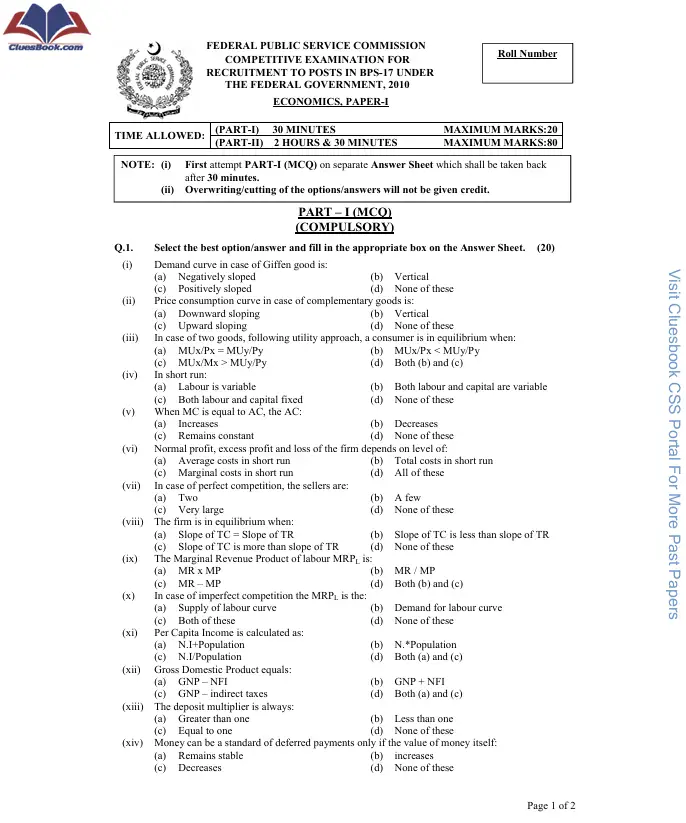Exploring Economics Past Papers CSS 2010 | Complete Breakdown
The Economics Past Papers CSS 2010 exam tested deep knowledge of microeconomics, macro theories, and Pakistan’s economic structure, like defining national income and deficit financing, with real-world relevance.

For example, one question asked why Pakistan uses deficit financing, linking textbook theory to national policy. This blog decodes the full paper in a friendly, digestible way!
Overview of CSS Economics Paper 2010
The CSS Economics Exam 2010 was structured to challenge candidates across both theoretical understanding and application to Pakistan’s real-world economic landscape. The exam was divided into:
- Paper-I: Core Economics (Micro & Macro)
- Paper-II: Applied Economics, with a focus on Pakistan’s economy
Each paper had:
- Part-I: 20 MCQs (Objective type, 30 mins)
- Part-II: 4 Essay Questions out of 8 (Subjective, 2.5 hours)
Paper I: Core Economics Concepts Explored
Multiple Choice Section (Part I)
This section tested foundational microeconomic and macroeconomic principles such as:
- Demand curve behavior for Giffen goods
- Consumer equilibrium conditions
- GDP, GNP, and national income calculations
- Concepts like MRPL, deposit multiplier, fiscal policy, and balance of trade
Pro tip: Focus on understanding economic terminology and models like utility functions, perfect/imperfect competition, and classical theories.
Subjective Section (Part II) – Choose 4 out of 8
Here’s a breakdown of the key topics:
Consumer Equilibrium Using Ordinal Approach
- Explained through indifference curves and budget lines
- Equilibrium occurs when MRS = Price Ratio
Demand Curve for Factor Inputs
- How labor or capital demand is derived when there’s one or multiple inputs
National Income Concepts
- GNP, GDP, NNP, PI, DPI
- Focus on real vs nominal income
Equation of Exchange and Velocity
- Quantity Theory of Money (MV = PQ)
- Assumptions like constant velocity and output at full employment
Balance of Payments vs. Balance of Trade
- Differences in current account and capital account transactions
Ricardian Theory of Comparative Cost
- Basis for international trade using opportunity costs
Deficit Financing
- Methods like borrowing or printing currency
- Pakistan’s reasons: development needs, fiscal deficits
Paper II: Pakistan’s Economic Landscape
Multiple Choice Section (Part I)
Focused on:
- Economic indicators like HDI, PQLI
- Agriculture, trade, planning history
- Concepts like primary deficit, soft loans, debt overhang
Subjective Section (Part II) | Key Questions
Economic Growth vs Development
- Growth = quantitative (GDP rise), Development = qualitative (education, health)
Trends in Pakistan’s Foreign Trade
- Export structure, trade balance, and dependency patterns
Foreign Aid & Debt
- Evaluated cost-benefit and suggested policy reforms
Industrial Policy Measures
- Monetary and fiscal steps like tax holidays, low-interest loans
Land Tenure System
- Ownership types, reforms, and rural implications
Cooperative Farming in Pakistan
- Why it failed: lack of trust, poor administration
Economic Planning Strategy
- Five-Year Plans, challenges in implementation
About the CSS
The CSS (Central Superior Services) Competitive Examination is a rigorous federal-level test administered by the Federal Public Service Commission (FPSC) to select candidates for prestigious civil service roles across Pakistan. The exam’s rules and regulations, covering age limits, eligibility, subjects, and quotas, are detailed in the official CSS Rules section on the FPSC’s website.
The CSS Exam Rules, issued by FPSC Pakistan, outline eligibility criteria, age limits (21–30 years), and a maximum of three attempts for candidates. The exam includes written tests, a medical exam, a psychological assessment, and an interview. Rules also define quotas, disqualification grounds, and subject selection for a fair recruitment process.
Takeaways for Aspirants
- Paper I prepares you to handle economic logic and classical theories.
- Paper II expects real-world application in the Pakistani context.
- Prioritize mastering both global theories and national economic data.
The CSS Economics 2010 paper blended theory with contemporary relevance, making it a great model for understanding exam expectations.
Use it to shape your preparation strategy, focusing on both academic clarity and Pakistan-specific insights.

